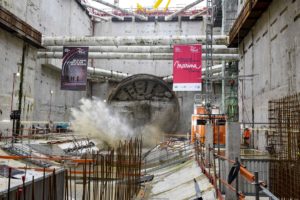High Altitudes for Caprari Submersible Pumps
The alarm was raised last July by Grenoble s laboratory of glaciology. A huge pocket containing some 65 000m³ of water had formed under the Tête-Rousse glacier on Mont Blanc.

Caprari
It was not the first time that a reservoir like this had formed under the glacier. In 1892, the water in a similar pocket burst through the ice and a deadly flood buried the town of Saint Gervais killing 175 people. In view of the emergency and the number of residents now living in the valley, the population having increased considerably over the last decades, the mayor of Saint Gervais and the provincial governor of Haute-Savoie took immediate action and decided to have this pool of water emptied as rapidly as possible so as to prevent the area from being endangered.
The event aroused great interest as it was widely covered by the press (Le Figaro) and televised news services.
Emptying this pocket was a delicate operation of immense proportions. The glacier is situated at an altitude of 3200 m, thus the work was certainly not easy to carry out. The water pocket had formed at a height of about forty meters and was more than 30 meters deep.
8 bore holes 250 mm in diameter were drilled straight into the ice using a thermal technique with hot water so as to melt the ice at high speed.
The thermal process needed to make rapid use of reliable, sturdily built submersible pumps with small outer diameters, each with a flow rate of 80m³/h. The choice fell on CAPRARI, through its French branch which, in the month of August, had the 8 machines required in stock. Since the maximum diameter of the largest ones was merely 182 mm, these pumps were easy to install in the bore holes with ample room for the electric power cables. All the materials for the pumping operations were consigned in less than 4 days and were transported to the area via helicopter.
The following two pump models were considered:
- 4 (four) 26 kW 8” mixed flow pumps for the highest pumping point (80 m³/h @ 75)
- 4 (four) 5.5 kW 6” mixed flow pumps for the lowest pumping point (15 m³/h @ 75)
The electric power required to drive the machines was provided by powerful electric generating sets supplied by DELTA SERVICE LOCATION (DSL), specialized in emergency pumping operations.
Once the pumps had been immersed in the water pocket, the process required to empty these 65 000m³/h of water, equivalent to more than 20 Olympic swimming pools, got off to a start and proceeded at a constant rate without a hitch. The water subsequently reached the rivers in a completely normal way. After a few days of pumping, the water level had dropped by more than 20 m, thus reducing the pressure under the glacier by over 2 bar and making the conditions safe for the inhabitants.
Source: Caprari S.p.A.






